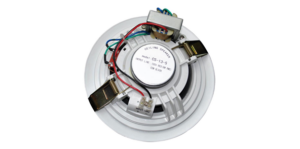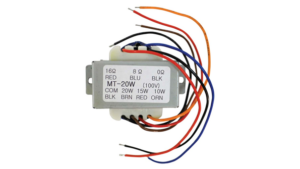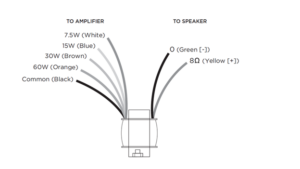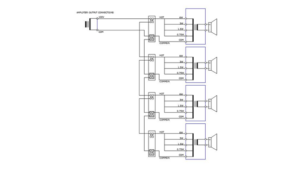Audio Systems - Basic Principles of a PA System
This article will cover basic Distributed PA Systems, and look where this type of PA System is found, its functionality and versatility.
By Marius Van Vuuren
So far we’ve discussed the following:
- How a PA System works, and its intended function
- Basic Elements on how to connect a PA System and splitting this up as sources, modifiers and destinations.
- Types of PA Systems,
- Full Range Point Source PA System
- Two-Way PA System
- Three-way PA Systems
- The fundamental differences between a Two-Way and Three-Way PA System
This article will cover basic Distributed PA Systems, and look where this type of PA System is found, its functionality and versatility.
So, what is a Distributed PA System?
A distributed audio system simply delivers audio to many speakers rather than to just a few.
Distributed PA Systems can be found in fully integrated meeting rooms or boardrooms, hotels, schools, supermarkets, health clubs, shopping malls, etc.
These systems are commonly referred to as “constant power systems” or “70 volt systems” or even “100V line systems”. For this article, we will look at 100V line systems.
Why will a normal 8Ω speaker not work in a Distributed PA System?
The typical 8-ohm speakers you might use in a home hi-fi system or a basic PA system wouldn’t work well as for a distributed audio system. The purpose of a distributed PA System is to amplify a lot more speakers and, critically, they’re much, much farther away from the amplifier than they are in your living room.
To get around this, distributed audio systems make use of a typical 8-ohm speaker, but with the addition of a transformer. The transformer essentially steps down voltages coming to the speaker.
Also important to note is that amplifiers in a distributed system send 100V to the speakers, hence why it’s important to step down the voltage to enable the use of multiple speakers with transformers connected to them.
To get around this, distributed audio systems ordinarily use 8-ohm speakers with an important modification: a transformer that takes a 100V input and steps it down to the lower voltages needed by the 8-ohm speaker. To understand why this would make sense, we need to remember Ohm’s Law, which states:
P=VI (power = voltage x current)
The transformer isolates the speaker’s impedance load from the amplifier. The transformer can be set to a wattage rating, allowing for independent volume level for each speaker. The net result is a 100V line system allows for long ‘strings’ of speakers to hang off a single amplifier output, each speaker is connected to the next one in the circuit by daisy chaining the wiring.
Advantages and Disadvantages of 100V Line Systems
Advantages
- Being able to connect a number of speakers to one amplifier.
- As needs change, additional speakers can easily be added or subtracted from a circuit.
- Simple load calculation. Simply add together the wattage of each speaker in the string, and ensure it is below the rated wattage of the amplifier.
- Individual transformer “tap” settings allow tailored volume levels for each speaker.
- Suitable for use with long runs, making use of relatively small gauge speaker cabling.
Disadvantages
- Sound quality. Most 100V line speakers do not perform brilliantly at low frequencies, however for general announcing this is not generally a concern.
- Additional cost per speaker due to fitment of transformer, line monitoring capacitor and regulatory requirements (such as speaker, transformer enclosures and cable restraint plates).
- Usage is limited to paging, voice and low level background music applications.
How does a 100V Line System Work?
A 100V line speaker is operated by applying 100V RMS from the amplifier to the speaker step down transformer via suitable speaker cabling.
The step down transformer then converts the 100 Volts down to a standard speaker level to output audio to the speaker.
100V line amplifiers are a bit different from conventional amplifiers, but there are certain professional amplifiers that will produce 100V RMS or more when the amplifier is run in bridge mode. Always check the amplifier manufacturer specifications first before attempting to use the amplifier in bridge mode for a 100V line system.

Above is a typical distributed PA System speaker with a transformer. Always check the manufacturer specifications, speaker rating and transformer rating to make sure it will work for your planned installation.

Above is an example of a 20W transformer with tappings at 20W, 15W and 10W

The illustration above shows connections on a 60W transformer.
How many Speakers can I connect to my 100V Line System?
Each speaker should be wired in parallel and the wattage of each speaker tap is added together to find the net result of wattage load on the amplifier. So for instance, a 100W amplifier is capable of powering 100 speakers when each speaker is set to a 1W tap, or 50 speakers when each speaker is tapped at 2W, and so on.
You may turn up at an installation that was done years ago, and you have no idea how many speakers are installed or what power taps they have been set to. In this case you will need to resort to measuring the AC impedance of the speaker system.
Importantly, this differs from DC resistance that most multimeters offer as a standard range setting. To measure the AC impedance you will need a dedicated Audio Impedance meter.
Below is a table to work out 100v system loads (Impedance measured in Ω)
| LOAD | 100V SYSTEM |
| 0.5W | 20kΩ |
| 1W | 10kΩ |
| 2W | 5kΩ |
| 3W | 20kΩ |
| 5W | 3.3kΩ |
| 10W | 1kΩ |
| 15W | 666Ω |
| 20W | 500Ω |
| 30W | 333Ω |
| 40W | 250Ω |
| 60W | 166Ω |
| 100W | 100Ω |

As an example, the above schematic shows how four speakers are connected to a 100V line amplifier and the speakers with transformers, all wired together in parallel.
Here’s a few tips for 100V Line PA System Installations.
- Keep all the speakers in the same polarity. Amplifiers are marked with (+) and (-) on the 100V output terminals and speakers are marked with red and black on the terminal blocks. Maintain this polarity throughout your speaker circuit.
- Be conservative with your ratings. Always design a system with 20% spare capacity, so if you have 80W of speakers, buy a 100W amplifier. This allows for expansion of the circuit later or changes to individual power taps for areas that might need extra volume.
- Take advantage of higher wattage speakers where possible. If it means you need to buy and install less speakers overall the system will work out considerably cheaper.
- Cater for local attenuation (or volume level) control. More often than not people like to adjust the level of sound in their work environment, especially with background music. Allowing for local level control makes it easy to set a comfortable volume.
- Fixing or expanding an existing install? Use an impedance meter! It’s an essential tool for a PA installer to ensure the speaker load stays below the amplifier rating.
- Do not EVER mix 100V line speakers with traditional low impedance speakers within the same circuit. 100V Line amplifiers are not designed for powering low impedance speakers and 100V line speakers at the same time. If this is required, the suggestion is to use two completely separate amplifiers, one for 100V Line speakers and another for low impedance speakers.
Quick Recap
So, we’ve learned the following with Distributed PA systems:
- Distributed PA systems are commonly referred to as 100V line systems.
- 100V line systems have a multitude of speakers connected in parallel to one amplifier.
- The speakers in a 100V line system all have transformers to step down voltages coming to the speaker.
- A 100V line system is limited to the amplifier output power and number of speakers tapped at the appropriate wattage.
- Calculate your systems overall wattage and calculate at least 20% additional amplifier power for future speaker additions.
Latest Blog
No results found.....